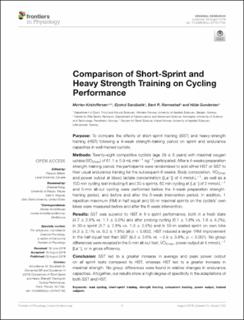Comparison of Short-Sprint and Heavy Strength Training on Cycling Performance
Peer reviewed, Journal article
Published version
Permanent lenke
https://hdl.handle.net/11250/2712524Utgivelsesdato
2019Metadata
Vis full innførselSamlinger
Sammendrag
Purpose: To compare the effects of short-sprint training (SST) and heavy-strength training (HST) following a 4-week strength-training period on sprint and endurance capacities in well-trained cyclists.
Methods: Twenty-eight competitive cyclists (age 29 ± 6 years) with maximal oxygen uptake (VO˙ 2max) of 61.1 ± 5.9 mL·min−1 ·kg−1 participated. After a 4-weeks preparation strength-training period, the participants were randomized to add either HST or SST to their usual endurance training for the subsequent 6 weeks. Body composition, VO˙ 2max and power output at blood lactate concentration ([La−]) of 4 mmol·L −1 , as well as a 100 min cycling test including 6 and 30-s sprints, 60 min cycling at [La−] of 2 mmol·L −1 and 5-min all-out cycling were performed before the 4-week preparation strengthtraining period, and before and after the 6-week intervention period. In addition, 1 repetition maximum (RM) in half-squat and 55-m maximal sprints on the cyclists’ own bikes were measured before and after the 6-week intervention.
Results: SST was superior to HST in 6-s sprint performance, both in a fresh state (4.7 ± 2.6% vs. 1.1 ± 3.5%) and after prolong cycling (6.1 ± 1.8% vs. 1.8 ± 4.2%), in 30-s sprint (3.7 ± 2.8% vs. 1.3 ± 2.5%) and in 55-m seated sprint on own bike (4.3 ± 2.1% vs. 0.2 ± 1.8%) (all p < 0.002). HST induced a larger 1RM improvement in the half-squat test than SST (9.3 ± 3.6% vs. −3.9 ± 3.8%; p < 0.001). No group differences were revealed in the 5-min all-out test, VO˙ 2max, power output at 4 mmol·L −1 [La−], or in gross efficiency.
Conclusion: SST led to a greater increase in average and peak power output on all sprint tests compared to HST, whereas HST led to a greater increase in maximal strength. No group differences were found in relative changes in endurance capacities. Altogether, our results show a high degree of specificity in the adaptations of both SST and HST.
Beskrivelse
Copyright © 2019 Kristoffersen, Sandbakk, Rønnestad and Gundersen. This is an open-access article distributed under the terms of the Creative Commons Attribution License (CC BY). The use, distribution or reproduction in other forums is permitted, provided the original author(s) and the copyright owner(s) are credited and that the original publication in this journal is cited, in accordance with accepted academic practice. No use, distribution or reproduction is permitted which does not comply with these terms.
Tidsskrift
Frontiers in PhysiologyBeslektede innførsler
Viser innførsler beslektet ved tittel, forfatter og emneord.
-
Equal-Volume Strength Training With Different Training Frequencies Induces Similar Muscle Hypertrophy and Strength Improvement in Trained Participants
Hamarsland, Håvard; Moen, Hermann; Skaar, Ole Johannes; Wahlstrøm Jorang, Preben; Sæterøy Rødahl, Håvard; Rønnestad, Bent (Peer reviewed; Journal article, 2022)The main goal of the current study was to compare the effects of volume-equated training frequency on gains in muscle mass and strength. In addition, we aimed to investigate whether the effect of training frequency was ... -
Adaptations to strength training differ between endurance-trained and untrained women
Vikmoen, Olav; Raastad, Truls; Ellefsen, Stian; Rønnestad, Bent (Peer reviewed; Journal article, 2020)Purpose: The purpose of this study was to investigate if endurance athletes, sustaining their normal endurance training, experience attenuated adaptations to strength training compared to untrained individuals. Methods: ... -
Interval-training at higher percentages of VO2max induces greater training adaptions than lower percentages in cyclists
Odden, Ingvill (Master thesis, 2022)Purpose: Training at high intensities is well known to improve endurance performance, yet the importance of training intensity measured as percentage of maximal oxygen consumption (VO2max) has never been verified. Thus, ...

